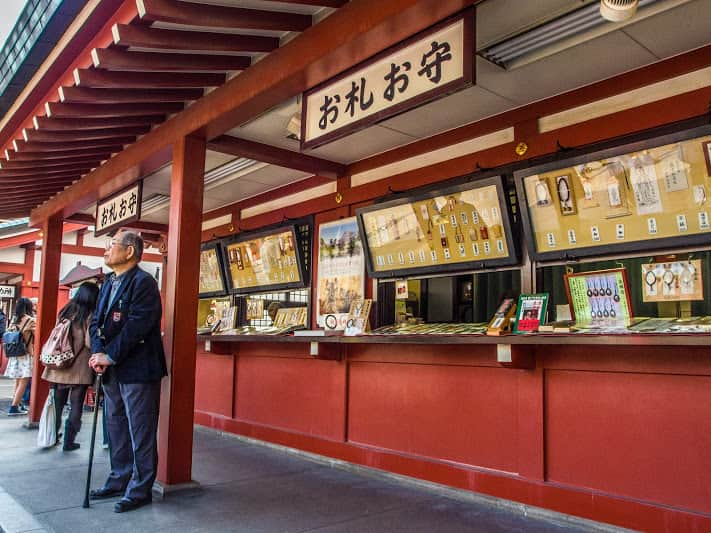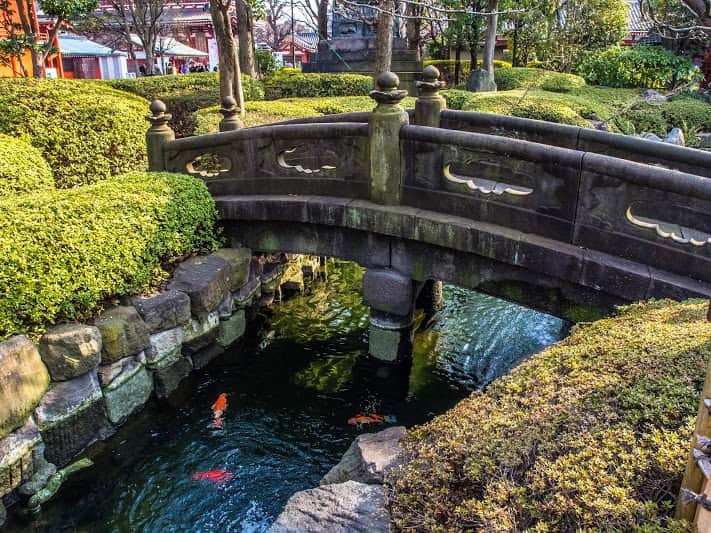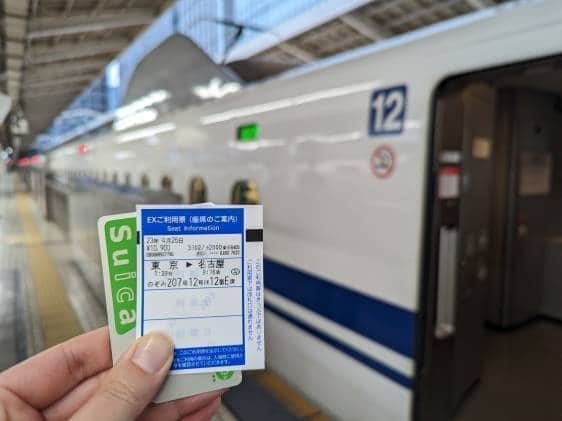In a city full of temples, Sensōji is the oldest, boasting almost one and a half millennia of history. It features Tokyo’s biggest souvenir market, as well as perhaps the gaudiest rendezvous point—its Kaminarimon Gate with the huge red chochin lantern. Sensōji Temple in Asakusa is just a 15-minute train ride from Tokyo Station (20 from Shinjuku, 30 from Shibuya or just 5 from Akihabara)—here’s what to know and how to explore the place.
The history of Sensoji: It all started in the river
Sensōji Temple was the reason the insignificant village of Asakusa became a town. Ieyasu, the Tokugawa shogun who created the great city of Edo and made it Japan’s de facto capital in the early 1600s, saw in Sensōji a very convenient symbolism. Being the toughest warlord of his time, he needed all the help he could get from the gods and Buddhas. According to ancient geomancy, potential invaders come either from the northeast or the southwest, the front and rear “demon gates”. Sensōji Temple was the guardian of the northeast gate and Zojoji Temple in Shiba, near Tokyo Tower took care of the southwest; Ieyasu made them both his family temples.

When this happened, Sensōji Temple was already 1,000 years old. Its chronicles put its founding at 628 AD through one of these stories that legends and religions are made of: While fishing in the Sumida River on the morning of March 18, the brothers Hinokuma Hamanari and Takenari caught in their nets a small golden statue of the Buddhist deity Kannon. They tried to get rid of it, but it kept coming up so they decided to keep it. When they returned to the village, they showed it to one of the chieftains Haji no Nakatomo who being a devout Buddhist understood what it was and built a temple to house it. The temple was, of course, Sensōji. “Senso” is another reading of the characters for “Asakusa” and “ji” is “temple”.

The miraculous statue became a local legend and soon pilgrims from all over Japan started flocking in; some of them being distinguished Buddhist leaders and advertising their visits to their followers didn’t hurt either. The only thing missing was the support of the samurai and this came later during the 10th and 11th centuries when noble warlords from the powerful Taira and Minamoto families came to visit and help build/rebuild various parts of the temple complex. One of them, Taira no Kinmasa is responsible for both the Kaminarimon Gate and the second largest gate the Hozomon.
Sensōji Temple (and Asakusa—their stories always go together) really boomed during the Edo period, first when Ieyasu made it his family temple and even more so when he “decommissioned” it in 1625. With its status as “shogun’s temple” gone, the townspeople of the new city felt closer to it. When the authorities decided to move to its vicinity Edo’s already famous red-light district, Yoshiwara (this happened in 1657 because a fire had destroyed the original Yoshiwara near Nihonbashi), the crowds multiplied. Consequently, Asakusa became the city’s hub and Sensōji Temple became even bigger and wealthier. It was then that the temple as we know it today was first built, by Ieyasu’s grandson, Iemitsu, the third Tokugawa shogun.
The layout of Sensoji: What to see
Making your way from gate to temple is a pretty easy stroll, but there’s an incredible amount to see along the way, from gates to ancient shopping streets to intimidating statues.
Kaminarimon: The ancient gate

There are many ways to visit Sensōji and appreciate the temple and its surrounds, but the standard is to start from the Kaminarimon Gate and move up. The two statues guarding it are of the two rather obscure deities Fujin-sama and Raijin-sama, “god of wind” and “god of thunder and lightning” respectively. The latter (i.e. the left one) has given his name to the gate since another reading of “rai” is “kaminari”. Incidentally, this is what the characters on the big red lantern say: “Kaminarimon” or “thundergate”. When passing through the gate, check under the base of the lantern—you’ll find a dragon hiding there! This is because the official name of Sensōji Temple is “Kinryuzan” or “Golden Dragon Mountain”; the same thing is written on the green plate above the lantern.
Nakamise-dori: The famous shopping street

The street lined with shops (mostly souvenir but also regular shops, some of them over 100 years old) is Nakamise Dori, meaning “inside street”, i.e. inside the temple grounds. They might seem like a recent invention to help relieve you of your tourist dollars, but actually the Nakamise goes way back: you can find it in pilgrim guides from the times of Edo. Apparently, 18th—century Edoites were as entrepreneurial as 21st—century Tokyoites and 18th—century pilgrims were as consumeristic as we are today! You can buy your souvenirs here—pretty much everyone does—but (a) there are some alternatives too and (b) let’s see Sensōji first, OK?
Somewhere in the middle of Nakamise you’ll see on your left a yard filled with “no photographs allowed” signs—reason being there is a kindergarten there that belongs to Denbōin Temple (which is part of Sensōji and residency of its abbot). Denbōin is almost always closed but if you happen to be here in the spring, check for the possibility it is open to visitors: once a year there is an exhibition of artworks from Sensōji’s collection in one of Denpoin’s buildings and by visiting this you also get to see its garden (it’s beautiful!).
The pagoda, the second gate and the nio within

After you’ve passed Denpoin, you have almost reached the real thing: the Hozomon, Sensōji Temple’s actual main gate (originally from the early 10th century like the Kaminarimon, but of course rebuilt) and to the left the Goju no To five-storied pagoda (there are very few of them in Tokyo so take lots of pictures!) The pagoda, also from the 10th century is always closed to visitors because, well, it’s a graveyard. It contains memorial tablets of thousands of families and individuals, so you can only see its insides if you can prove that you have family there, so to speak, and even then only during very specific times of the year.
Next to the pagoda is the Hozomon with its two Nio statues/protectors. The story goes that the models for them were 1960s sumo wrestlers Kitanoumi (on the left) and Myobudani Kiyoshi (on the right). The sculptor who made the right statue comes from a city called Murayama in Yamagata Prefecture. To honor him and the fact that Sensōji was kind enough to offer him the opportunity to showcase his work (in such a grandiose way!), 800 citizens of Maruyama get together every few years and create a pair of enormous waraji straw sandals—you will see them at the back side of the gate but don’t get too close: they weigh about 2.5 tons each!
The Hondo: What’s inside Sensoji?

Having passed the Hozomon Gate, you’ve reached Sensōji proper, the main temple (Hondo or Kannon-do) still houses the statue of Kannon the fishermen found 1400 years ago (or so they say: the statue was allegedly so radiant that they buried it in the ground inside Sensōji Temple and no one has actually seen it since). The shops at both sides of the last stretch sell the official Sensōji merchandise: omamori amulets, scrolls, incense to burn at the huge burner in front of the temple’s stairs, books about the temple, (in Japanese) and omikuji fortunes. If you aren’t set on some particular souvenir, something from there will be cheaper and more worthy as a conversation piece. Personally I’d go for the goshuin calligraphy with the temple’s red stamp and the date of your visit: it goes for ¥500 and it’s written just for you by the temple’s priests.

Hondo’s (the main temple) visiting hours are 6am to 5am and it’s really worth going up the stairs and wandering around. If you do, don’t neglect to look up: some of the greatest artworks from Sensōji’s collection are painted directly on the ceiling or are hanging on the upper part of the walls. The room where the services take place is also open and you can watch, but usually you aren’t allowed inside. If you want to try though, the entrance is on the right side and there’s always a guard to provide you with information.
Bonus gardens, shrines and koi
Leaving Hondo there are two ways to go: If you go right, there’s Asakusa Jinja, the Shinto shrine were the three men responsible for the founding of Sensōji are venerated. (Remember the two fishermen and their village elder? They are the ones, hence Asakusa Jinja’s crest is three nets symbolizing the ones they used to catch the statue.) Here, by the way you have Japan’s unique mix of religions: the statue is worshipped in Sensōji and the people who found it are enshrined in the Jinja and the two aren’t related—they don’t even belong to the same faith!
If you go left, you come to what is left of Sensōji’s once huge compound. Most of it has disappeared but there are still a few halls like the Yogodo with a beautiful little garden featuring Tokyo’s oldest stone bridge (made in 1618), the Yakushido and the Awashimado, all built in the Edo period to house various Buddhist saints and to help various highbrows, (shoguns included) atone for their sins.

Besides Asakusa Jinja, there’s also Bentendo on a small hill with a huge bell, one of Edo’s six-hour bells (now it’s only stricken once at 06:00) and the garden with the statues—the most impressive are two “Buddhas” (well, Boddhisatvas, sort of like saints), from 1687. The one on the left is Seishi and the one on the right, Kannon; yes the same Kannon that Sensōji is dedicated to (so even if you don’t get to see the actual statue, you get to see how Kannon supposedly looks like). Also before entering Nakamise Dori again, check the ablution fountain with the wonderfully detailed dragon king bronze statue. Why not rub some of the smoke from the huge incense burner to any part of your body that might ache? It’s supposed to make it feel better. I won’t comment on the fact that most Japanese people rub it on their heads!

One of the most popular activities in and around Sensoji is to try out a kimono, with rental stores to be found left right and center. We have some suggestions here – with the majority serving Japanese and foreign customers alike. For nearby ideas, check out our top picks for what to do in Asakusa and consider wandering over to the kitchenware hub of Kappabashi.
Festivals: The biggest and best
Asakusa has a whole lot of festivals, which isn’t surprising given its history. We have a full run down of them on our event pages for the area, but heres’ a run-down of some of the biggest hitters.
- Setsubun | Feb 3rd: Held across the country, this bean-throwing event is extra fun at Sensoji as the crowds and traditional demons are joined by the Seven Lucky Gods for the Fukuju-no-mai – a dance to honour the virtues of Kannon, the goddess of Mercy.
- Sanja Matsuri | 3rd full weekend in May: This is the biggest event in town, and it’s incredible, with dances, parades and local crowds carrying mikoshi – portable shrines.
- Sumidagawa Fireworks Festival | August : The biggest fireworks festival in Tokyo may not take place in the temple, but it’s right next door and we’d be amiss if we didn’t at least mention it.
- Hagoita-Ichi Fairs I, II and III | Nov-Dec: This is a series of unusual bat-selling fairs that take place leading up to the year’s end, and while once used for a casual game of hanetsuki, now they’re ornamental, and when we say ornamental, we mean ornamental. There are mutliple versions of this event, check our full guide for more info.
Tours: Taking a stroll, taking a ride
There are, of course, a wide range of tours available for Sensoji—from walking to rides in rickshaws – and sometimes with both.
- Take a ride with this Asakusa Rickshaw Tour
- Or dress to impress as you stroll with this kimono rental shop, just near Sensoji temple
The best Sensoji souvenirs

As we said above, Nakamise-dori is the place to go for souvenirs, and has been for centuries of shoppers—so don’t feel like a cheat. Yes, there are some ‘touristy’ things but there are also some truly beautiful and lovely things to be had, with many shops run by generations of famlily over the years. Consider whether you want items or food—with the latter being the best option if you’re planning to give them to Japanese friends or colleagues. For these, Kineya sells some seriously snappable rice crackers, called Senbei in Japanese, while Kimuraya is the oldest Ningyo-yaki shop (small cakes cooked on a griddle). You’ll also see quite a few spots selling piles of boxes—these are filled with small individually wrapped omiyage and are perfect for taking to the office orgiving to family.
If you’re looking for some more solid gifts, have a look for Daruma. These small, round characters are based on the founder of Buddhism and are sold with blank eyes—you color one in when deciding on your goal and the second when you achieve it. They’re great gifts as they’re light, small and a lovely bit of motivational Japanese culture. They’re temple-related as you can bring them to burn in New year’s celebrations, buying a replacement for a new goal. In other temple-related options, try getting a fortune for friends, some calligraphy as suggested above or an omamori amulet from the stalls near the main hall. Back on the shopping street, keep an eye out for traditional kokeshi dolls, small lucky charms and Sensoji-specific character merch like Hello Kitty—for fans these are a great find.
Where to eat near Sensoji

If all that exploration has worked up an appetite, then fear not, there’s plenty to eat around Sensoji, unsurprisingly. For sweet snacks, check out this guide—it has everything from the richest matcha ice cream to the famous and freshly-baked melon-pan.
For something slightly more substantial, then head to Sometaro for some truly satisfying okonomiyaki (think pancakes, cabbage and give it a pizza twist, and your part-way there). For tempura fans, hit up Daikokuya, loved for their rice bowls piled high with tempura (called tendon) and their teishoku (set-meal) options. If you’re feeling the chill, try the winter-classic of Oden at Otafuku and banish those convenience-store images of unidentified floating items—this broth-based dish is at its best here, with plenty of identifiable options to choose from. Asakusa is also home to a trusty Sushizanmai restaurant for that fish-fix as well as the very small Sushi Isshin, which is a more bespoke option for sure—it’s only open for dinner and requires reservations in advance.
How to get to Sensoji temple

Sensoji is super easy to access but has a slightly confusing quadruple station situation. This is great for access, but means meeting anyone is a bit of a nightmare—we suggest going for a landmark rather than a station exit.
The main station area is to the south-east of the Sensoji grounds and is home to the Tobu, Toei and Ginza Metro lines—these are all connected underground. The only overground station here is the Tobu Asakusa Station, which is found in the impressive Matsuya department store—keep an eye out for underground entrances or use this once and follow the signs for other lines. To the west of the Sensoji grounds is the TX Asakusa Station—home to the Tsukuba Express line, which runs from Akihabara to neighboring Ibaraki prefecture.
This combination of lines means you can get to Asakusa from pretty much anywhere, but here are some of the most popular routes:
- From Tokyo Station: You can walk 8-minutes to Kyobashi Station and catch the Ginza Metro line to Asakusa, taking 15 minutes and costing ¥200. Alternatively, take the JR Yamanote line to Ueno or Kanda and switch to the metro there, taking 18 minutes and costing ¥310 in total.
- From Shibuya: Take the Ginza Metro line direct to Asakusa, taking 32 minutes and costing ¥250
- From Shinjuku: Take the JR Chuo Line to Kanda and switch to the Ginza Metro line, taking 28 minutes and costing ¥340.
- From Akihabara: Take the Tsukuba Express direct to Asakusa, taking 5 minutes and costing ¥210
- From Ueno: Take the Ginza Metro line direct to Asakusa, taking 5 minutes and costing ¥0.
- From Shinagawa: For a direct route hop on the Keikyu Main/Airport Line and stay on at Sengakuji as it changes over, taking 20 minutes and costing ¥420. To save a few yen, catch the JR Ueno-Tokyo Line to Ueno and changing to the Ginza Metro line, taking 26 minutes and costing ¥370.
So there you have it: the basics of Sensōji, Tokyo’s oldest temple and the reason Asakusa exists. It looks like a tourist trap but it’s still the heart of a very lively community that has been living with visitors for over 500 years. The locals are generally friendly (sometimes they do get fed up with thousands of people photographing them every day) and they’ll happily offer information about the temple and its facilities if you ask. There are also hundreds of shops, restaurants and cafés around to satisfy almost any need and the best way to get its feel, i.e. by wandering around and watching people, is free! Even if other aspects of Tokyo are more to your taste, it would be a shame to miss it.
This post was originally published in April, 2015. Last updated in May, 2022.
- Places
- Restaurants


































